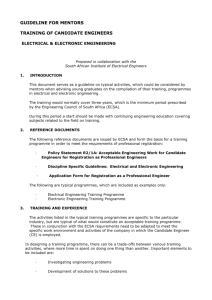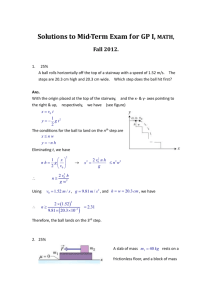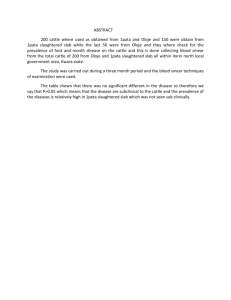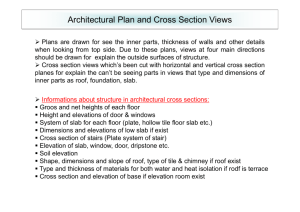Case Study 2012-2 The Design flaws leading to demolition
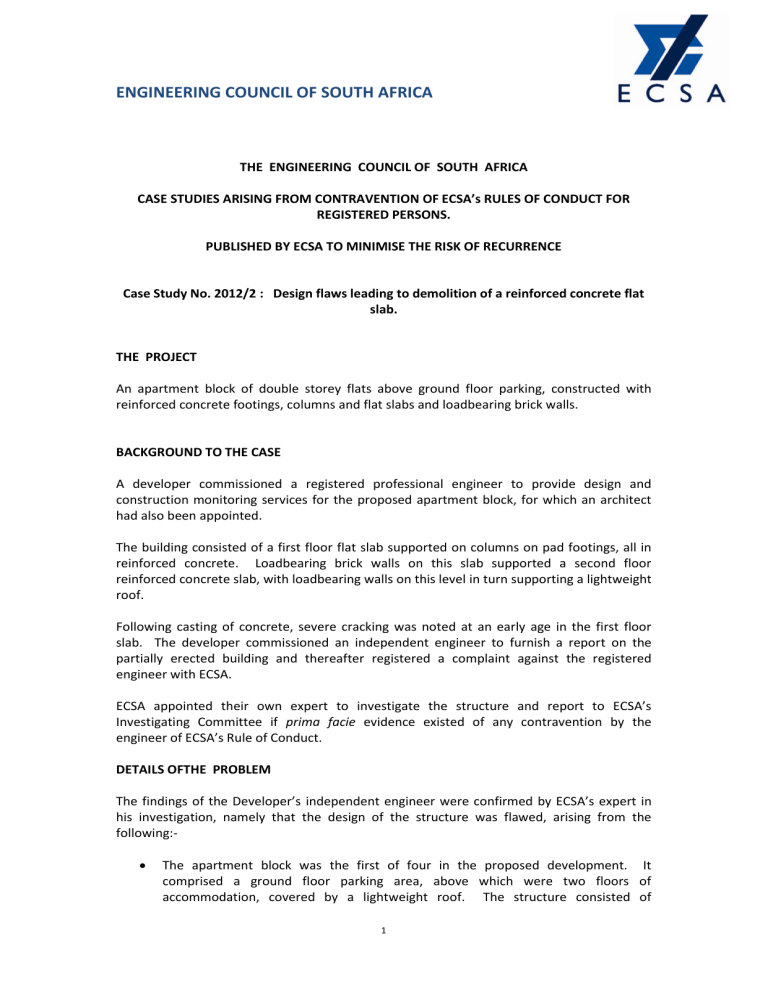
ENGINEERING COUNCIL OF SOUTH AFRICA
THE ENGINEERING COUNCIL OF SOUTH AFRICA
CASE STUDIES ARISING FROM CONTRAVENTION OF ECSA’s RULES OF CONDUCT FOR
REGISTERED PERSONS.
PUBLISHED BY ECSA TO MINIMISE THE RISK OF RECURRENCE
Case Study No. 2012/2 : Design flaws leading to demolition of a reinforced concrete flat slab.
THE PROJECT
An apartment block of double storey flats above ground floor parking, constructed with reinforced concrete footings, columns and flat slabs and loadbearing brick walls.
BACKGROUND TO THE CASE
A developer commissioned a registered professional engineer to provide design and construction monitoring services for the proposed apartment block, for which an architect had also been appointed.
The building consisted of a first floor flat slab supported on columns on pad footings, all in reinforced concrete. Loadbearing brick walls on this slab supported a second floor reinforced concrete slab, with loadbearing walls on this level in turn supporting a lightweight roof.
Following casting of concrete, severe cracking was noted at an early age in the first floor slab. The developer commissioned an independent engineer to furnish a report on the partially erected building and thereafter registered a complaint against the registered engineer with ECSA.
ECSA appointed their own expert to investigate the structure and report to ECSA’s
Investigating Committee if prima facie evidence existed of any contravention by the engineer of ECSA’s Rule of Conduct.
DETAILS OFTHE PROBLEM
The findings of the Developer’s independent engineer were confirmed by ECSA’s expert in his investigation, namely that the design of the structure was flawed, arising from the following:-
The apartment block was the first of four in the proposed development. It comprised a ground floor parking area, above which were two floors of accommodation, covered by a lightweight roof. The structure consisted of
1
ENGINEERING COUNCIL OF SOUTH AFRICA reinforced concrete columns on spread footings to underside of the first floor slab.
The second floor slab and roof were supported by loadbearing brick walls, resting on the first floor.
The loadbearing walls on first and second floors did not correspond with this position of the columns below the first floor, i.e. the first floor slab functioned as a transfer slab.
This slab was a flat slab without beams. In carrying the load of the roof, second floor slab and two floors of brickwork, the load on the slab was extremely heavy.
Longitudinal top cracks over column lines, radial cracks around columns, longitudinal cracks on the soffit, and top cracks at the root of cantilever slabs were observed, all in the first floor slab.
The slab was not designed as a flat slab able to transfer this loading to the columns resulting in the slab failing in various ways, attributable to design faults observed and detailed below.
the slab is too thin, needing compression reinforcement in places – an unacceptable practice.
bottom slab reinforcement was insufficient
too little top slab reinforcement.
inadequate reinforcement around columns to withstand punching shear forces.
insufficient anchorage lengths of cantilever slab reinforcement.
Other elements of the structure, including the column stirrup spacing, and starter bar lengths, plus excessive bearing pressure below footings if not founded deep enough, were noted.
The lateral stability of the structure in withstanding wind loads had not been considered. This would require shear walls.
During casting of the slab, the strength of the ready-mixed concrete had been questioned by the engineer; subsequent tests showed the strength to be marginal, but not a cause of the slab failure.
The omission of a geotechnical investigation and reliance on information from a nearby site for foundation design was a risk that should not have been taken.
In summary, considering the nature of the cracking and extent of deflection which had occurred, the slab could not be strengthened in situ and would have to be demolished. It was concluded there was prima facie evidence the engineer had contravened ECSA’s Rules of Conduct.
The engineer was accordingly charged with contravening ECSA’s Rules of Conduct as follows:
3(1)(b) (undertook work of a nature for which his education, training and experience have not rendered him competent to perform).
3(1)(c) (failed to engage and adhere to acceptable practices).
2
ENGINEERING COUNCIL OF SOUTH AFRICA
3(2)(b) (undertook work under conditions or terms that compromised his ability to carry out his responsibilities in accordance with acceptable professional standards).
3(3)(a) (did not at all times have due regard and priority to public health, safety and interest).
3(5)(c) (did not provide work or services of quality and scope and to a level which is commensurate with accepted standards and practices in the profession.)
In his defence the engineer maintained he had been retained to prepare a price estimate for the structure, not the detailed design. He understood moreover the contractor had been appointed to design and construct the building, and he had advised the contractor to retain a professional engineer for the design. In a preliminary design he estimated the amount of reinforcing steel on a kg/cubic metre basis, which in hindsight was too low. His initial cost estimate was moreover reduced by his client. The engineer also maintained that the concrete strength of the slab was too low, evidenced by inefficient placing and compacting by the contractor (with whom he was not connected). It transpired that water had been added to the concrete mix on delivery, which contributed to the low strength. It could not be proved however that this was the cause of the cracking and deflection of the slab.
The engineer further maintained he was never appointed as the structural engineer for the project, but acknowledged to ECSA his Local Authority’s appointment as the responsible person.
The engineer pleaded guilty to the charges. He had been aware the structure had not been designed by a competent person, yet he had signed the A19 form of the local authority, as the responsible person. He entered into a plea bargain process with ECSA, pleading guilty to
Rule of Conduct 3(1)(c) and accepting a suspension of practice for 6 months, plus imposition of a fine by ECSA in the amount of R20 000. A settlement agreement was signed and presented to an ECSA Tribunal for ratification.
At the tribunal hearing the engineer read a statement to the Tribunal asking the Tribunal’s acceptance of the settlement agreement, taking into consideration his length of experience in construction (now retired from full time service), that this was a first offence, that it had taken an inordinate time to resolve the matter, and his undertaking not to undertake any such design in future. This was accepted and the settlement was made on order of the
Tribunal.
3
ENGINEERING COUNCIL OF SOUTH AFRICA
WHAT LESSONS CAN BE LEARNED ?
Lessons to be learned are considered under various headings:-
In design of the structure:
1.
The omission of a geotechnical investigation on the site for a structure such as the above cannot be condoned. Should settlement of foundations occur when the soil bearing capacity is exceeded, this can redistribute the forces on the structure, leading to cracking, deflections and risk of collapse. Furthermore, rigid brick walls in the structure will be prone to cracking.
2.
An element such as the first floor slab in this structure acts as a “transfer slab”, having to transfer loads from above to the columns beneath where such loads are not directly above the columns. This requires detailed calculations additional to those required for normal design of the slab. They should never be ignored.
3.
The design of the structure did not take its lateral stability into account. There was no provision for transferring loads (eg wind) down to the ground, using shear walls or similar. Again this provision cannot be omitted.
In execution of the assignment:
4.
There was apparently no written agreement between client and engineer specifying his scope of services including both design and site monitoring duties. A written agreement, which clearly allocates responsibilities, is essential.
5.
In terms of National Building Regulation A19 the person appointed by the owner to be responsible for the design is required to sign the Building Control form of the local authority. This regulation requires appointment of “a professional engineer or other approved competent person” to undertake responsibility for the design and inspection of the work, to check compliance with the approved design and to inform the authority “if it appears that any structural work is being carried out in a manner which may endanger the strength, stability or serviceability of the building”. This form should not be signed by a person unable to assume such responsibility. Also, a failure to inform the authority could be construed as contravention of ECSA’s Rules of Conduct.
In complying with ECSA’s Rules of Conduct:
6.
The conduct of the engineer clearly showed Rule 3(1)(c) had been contravened by his failing to engage and adhere to acceptance practices. Before undertaking any assignment or work, the registered person is well advised to determine what are the acceptable practices required, and to ensure compliance therewith.
-o0o-
4




